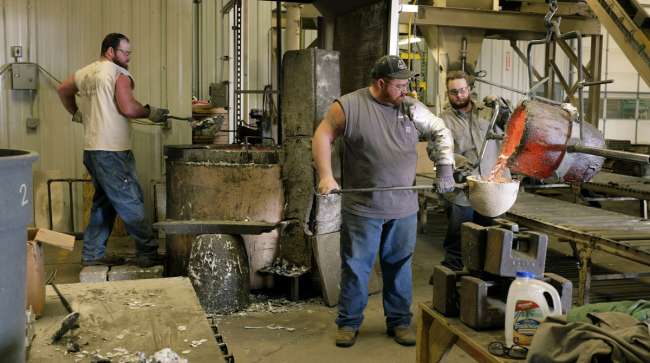The Current State of U.S. Manufacturing Employment
The past year hasn’t been kind to manufacturing job numbers in the United States. After a hopeful push toward industrial growth, payrolls in this vital sector have contracted for the fourth consecutive month as of August, shedding 12,000 jobs, with an overall loss nearing 80,000 jobs in the last twelve months. This downturn marks the most extended streak of declines since 2020, suggesting that the manufacturing renaissance once touted has hit a rough patch.
Broader Employment Context
This slump in manufacturing mirrors a wider employment slowdown. Nationwide, job growth has slowed to a crawl, with private companies adding only about 22,000 new positions last month and the unemployment rate inching up to levels not seen since 2021. The atmosphere feels cautious, as employers tread lightly both on hiring and firing, a sign of uncertainty in the economic air.
Trade Policies and Manufacturing Activity
The manufacturing sector is grappling with the fallout from sweeping trade and tariff policies designed to reignite domestic production. These measures were branded with the promise of long-term gains, requiring some short-term sacrifice. Yet, the tensions brought on by tariffs and related uncertainties seem to have chilled demand and investment rather than sparked a boom — as evidenced by the Institute for Supply Management’s report noting a contraction in manufacturing activity since early in the year.
Investment vs. Employment Reality
Despite government assertions highlighting significant commitments from major corporations like Apple, AbbVie, and Ford to ramp up production domestically, the job market hasn’t yet mirrored this optimism. Executives often emphasize that capital investments precede hiring, so there’s a lull while these factories form the groundwork. Still, many in the industry are skeptical, citing weak overall demand as the primary cause for contraction. Around sixty-nine percent of manufacturing GDP currently reflects this downturn.
| Key Manufacturing Figures | Значення |
|---|---|
| Job Losses Over Last Year | ~80,000 |
| Jobs Lost in Latest Month (August) | 12,000 |
| Percentage of Manufacturing GDP in Contraction | 69% |
| Change in Unemployment Rate | Up to highest since 2021 |
The Logistics Angle: What Manufacturing Decline Means for Freight and Shipping
This manufacturing slowdown ripples directly into the logistics and transportation sectors. Less factory output means fewer goods moving along supply chains, ultimately hitting freight, shipping, and distribution networks. For logistics providers and cargo movers, these job cuts translate into a slowdown of cargo shipments and less overall haulage demand, impacting revenue and operational planning.
It’s no secret that when manufacturing stumbles, the entire supply chain feels the tremors. Forwarding companies, couriers, and bulk goods movers face shifting volumes and fluctuating freight flows, adding complexity to distribution and forwarding services. Efficient transportation scheduling and handling of shipments become critical in balancing supply with changing demand.
Challenges and Opportunities in Cargo Transport
- Decreased manufacturing output may reduce freight volumes, challenging transport companies to optimize routes and consolidate shipments.
- Import tariffs and trade uncertainties can encourage domestic sourcing, which can gradually bring shifts in distribution patterns.
- Forwarding and haulage sectors must stay flexible to adjust to emerging market conditions and maintain reliable delivery timelines.
Looking Ahead: Insight, Experience, and Making the Right Moves
The situation in manufacturing is nuanced and, as always, the best insights often come from personal experience rather than just figures or forecasts. With the widely varying opinions in play, there’s no substitute for hands-on trials and solid, honest feedback when it comes to planning logistics and shipment strategies.
GetTransport.com shines in this arena by offering customers access to affordable, global cargo transportation — whether it’s office or home moves, vehicle transport, or bulky freight shipments. The platform’s wide range of reliable options empowers shippers to make smart, cost-effective decisions without breaking the bank or facing unexpected setbacks. Transparency, competitive pricing, and convenience are hallmarks of this service, making it easier than ever to navigate the challenging logistics landscape.
Забронюйте поїздку на GetTransport.com and make procurement of your freight and delivery solutions a breeze.
Summary and Closing Thoughts
The recent downturn in U.S. manufacturing employment highlights the complex relationship between trade policies, industrial investment, and job creation. Although substantial capital commitments are on the table, the impact on payrolls is yet to materialize fully. This manufacturing slump doesn’t just affect factory floors; it cascades through the entire logistics chain, influencing freight volume, shipment scheduling, and distribution networks.
For businesses and individuals needing reliable cargo handling, moving, and transport services during such unpredictable times, embracing flexible and affordable platforms like GetTransport.com can be a game-changer. By streamlining global freight, courier, relocation, and bulky goods transport with transparent pricing and a variety of options, it helps navigate the supply chain’s ebbs and flows smoothly.
In the fast-changing world of logistics, staying ahead means adapting to shifting manufacturing realities while ensuring cargo, pallets, containers, and shipments move without a hitch. GetTransport.com stands ready to support these needs, delivering dependable service whenever and wherever you need it most.

 Examining the Recent Slump in U.S. Manufacturing Jobs Amidst Expansion Promises">
Examining the Recent Slump in U.S. Manufacturing Jobs Amidst Expansion Promises">